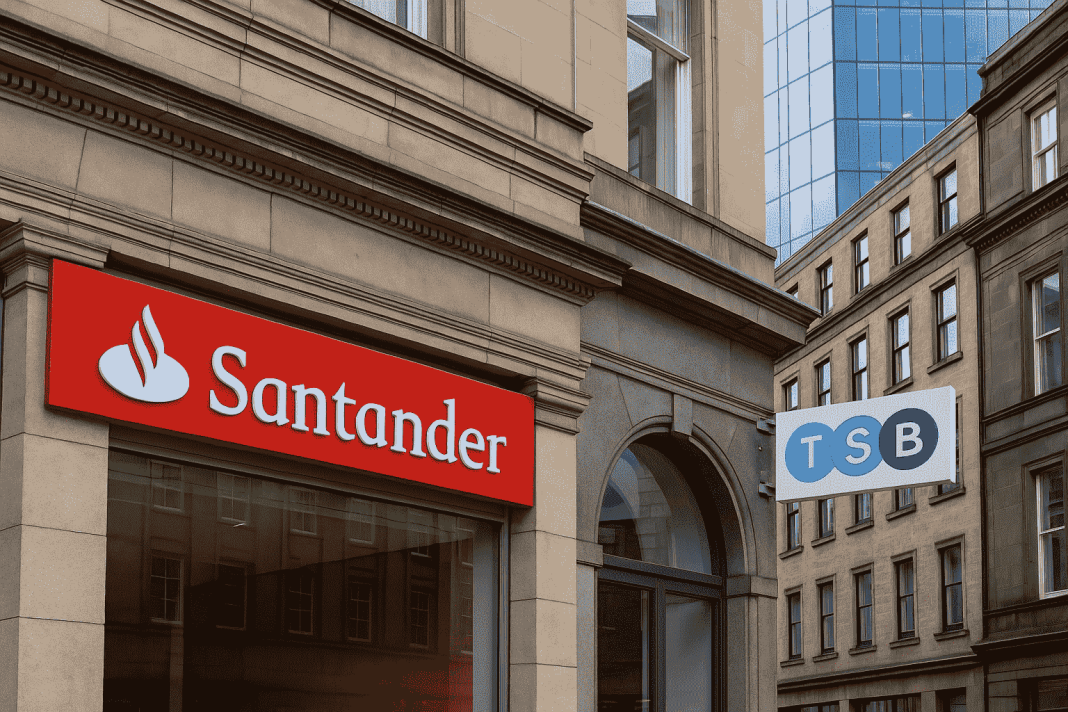A major shakeup is underway in the UK financial landscape as the Santander TSB merger sends shockwaves through the banking sector. In a blockbuster £2.65 billion deal, Santander has agreed to acquire TSB from Spanish banking group Sabadell, signaling a transformative shift for customers, employees, and the wider market.
Why the Santander TSB Merger Signals a New Era
The Santander TSB merger propels Santander to become the third-largest bank in the UK by personal current accounts. With 349 Santander branches and 175 from TSB, this union creates a formidable presence with over 28 million customers.
Finalized on July 1, 2025, the merger is subject to shareholder and regulatory approval. Santander beat out major rivals including Barclays to secure TSB, showing its strong commitment to the UK banking market.
For more on UK banking sector trends, visit Businessfits Banking News.
Strategic Goals Behind the Santander TSB Merger
The Santander TSB merger stems from strategic motives on both sides. Sabadell, facing increasing pressure from potential takeovers, opted to divest its UK arm. For Santander, this acquisition reflects a long-term investment in UK customers.
Executive Chair Ana Botín described the merger as a “strategic commitment.” The deal, currently valued at £2.65 billion, may rise to £2.9 billion by 2026, depending on TSB’s profitability TSB posted an impressive 89% surge in profits in Q1 2025, totaling £101.3 million.
This robust performance made TSB an attractive acquisition target, fitting perfectly into Santander’s broader growth strategy.
Santander TSB Merger: Concerns Over Job Losses and Closures
One of the most contentious aspects of the Santander TSB merger is the potential impact on staff and communities. The combined group will manage 524 branches, and Santander has announced plans to cut £400 million in costs by 2027 likely through branch consolidation and job reductions.
TSB employs over 5,000 people, while Santander has around 18,000 staff in the UK. While Santander insists there will be no immediate changes, overlaps in branch locations mean closures are probable.
Communities with a deep connection to TSB founded in 1810 in Scotland—fear losing a historic institution from their high streets.
Learn about UK employment rights during mergers on the UK Government’s employment transition page.
How the Santander TSB Merger Affects Customers
The Santander TSB merger brings both opportunity and uncertainty for TSB’s five million customers. While Santander assures a “business as usual” approach for now, long-term changes could affect branch availability and service formats.
There’s speculation about whether the TSB name will disappear altogether. Integration into Santander’s UK group is planned, although branding and service transitions remain unclear.
Additionally, with a more dominant presence, Santander may push rivals like Lloyds and NatWest to innovate, potentially improving service standards across the industry.
Integration Timeline of the Bank Merger
Execution of the Santander TSB merger involves several phases. The sale first requires approval from Sabadell shareholders and UK regulators. If approved, integration of operations is set to complete by Q1 2026.
During this time, critical decisions will be made around staffing, branch closures, and digital transformation. Santander’s cost-efficiency drive will play a central role in shaping the future of this newly expanded network.
Internal restructuring and system unification will be key to the merger’s success.
Historical Perspective
The Santander TSB merger marks a new chapter in the long history of TSB. Originally founded in 1810 in Dumfriesshire, TSB merged with Lloyds in 1995, only to later split and be acquired by Sabadell in 2015.
TSB’s independent legacy over two centuries old is at risk of fading. Its network of 218 branches and fast-growing digital services have served millions of loyal customers. For many, the potential disappearance of the TSB name symbolizes the loss of a familiar institution.
Santander, meanwhile, has consistently expanded across Europe and the UK. Its 2025 branch closure program already signaled a shift toward digital efficiency a trend the TSB acquisition will likely accelerate.
Industry Experts on the Santander TSB Merger
Financial analysts widely view the Santander TSB merger as a bold strategic move. It strengthens Santander’s position in retail banking and signals further consolidation among UK lenders.
Analysts on X (formerly Twitter) noted that the acquisition could lead to increased shareholder value for Sabadell, while also predicting growing pressure on smaller competitors.
Yet, regulatory and employee-related concerns persist. The £400 million in planned savings, while fiscally sound, has sparked fears of substantial job cuts.
Here is more about Santander branch close; 95 Santander UK branches close amid digital banking shift
Digital Transformation Accelerated by Santander TSB Merger
One lesser-discussed effect of the Santander TSB merger is the rapid acceleration toward digital banking. Santander has already invested heavily in mobile platforms and app-based banking. With TSB’s growing digital user base, the integration is likely to shift even more services online.
Customers may benefit from enhanced digital tools, but those relying on in-person service could find access increasingly limited. Balancing innovation with accessibility will be crucial for Santander’s post merger success.
What’s Next for the Santander TSB Merger?
As the bank merger progresses, several critical events are expected. These include:
-
Approval from Sabadell shareholders
-
Regulatory review and conditions
-
Staff realignment and branch assessments
-
Final integration by early 2026
This transformative deal could also serve as a blueprint for future mergers in UK banking. Smaller regional banks may find it harder to compete, leading to further consolidation.
Final Thoughts on the Bank Merger
The Santander TSB merger represents more than just a business transaction—it’s a turning point for the UK banking sector. Customers, employees, and communities alike must prepare for change.
As the dust settles, one question lingers: will the TSB brand, so deeply embedded in British financial history, disappear forever? Only time will reveal the true impact of this historic deal.
For ongoing updates and analysis, visit Santander UK’s newsroom.



